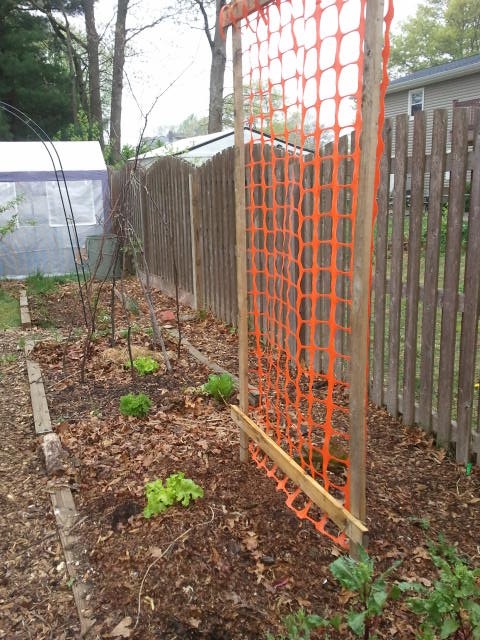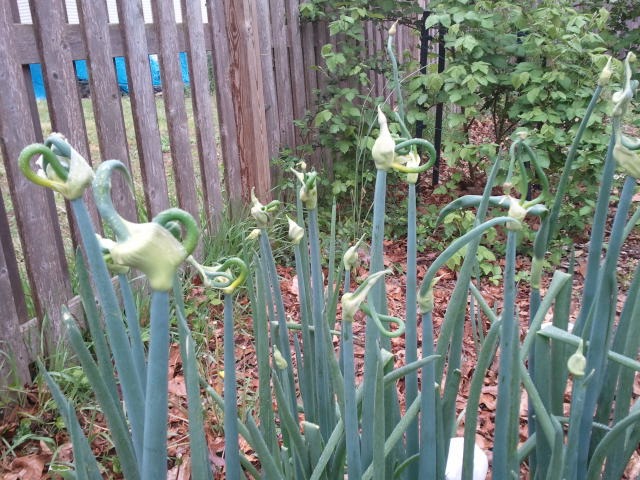Egyptian walking onions look different every season, I swear. I don’t remember them doing THIS last year, but then, this is only the second spring I’ve had them growing in the garden. Don’t they look weird? Those little pouches started out down at the base of the plant and moved up to the top over the last couple of weeks. I watched them daily and thought to myself “something’s coming”. Don’t ask me why, but it kind of reminded me of those big bat people from the movie Beastmaster. I’m so weird. Now they are busting open and there seem to be little onion plants inside. I guess these will fall over and replant themselves, but I wonder when those little bunching bulbs will happen on top of the plants. I can’t remember, is it in the fall?
There are aphids on my apple trees. I ordered 300 ladybugs from Amazon the other day and can’t wait for them to come so they can feast on those pesky aphids. I was looking into companion plantings for apple trees and I read that chives and dill are good to plant in an orchard as they attract the beneficial insects that feast on the bad guys. Today was misty and overcast all day, perfect planting conditions! I planted dill beneath my apples today and as soon as I get my hands on more chive seeds, those will grow there too.
I planted seeds for brocolli raab, carrots (tendersweet) in one of the veggie beds. Flat leaf parsley in with the asparagus, which I read was another good companion. I put nasturtiums and marigolds in the keyhole garden and here and there throughout the vegetable beds.
The garden twine I used to string my cucumber trellis came apart after our first good rain, so I used some plastic fencing on the trellis instead. That should hold, but I’m not sure if the tendrils on the cucumber will mind the sharp edges of the plastic. If they don’t, maybe I’ll use it for cherry tomatoes instead.
[su_row][su_column size=”3/4″ center=”no” class=””]
I’ve started spreading the load of mulch I got delivered last week. I’ve decided to use the wood chips for paths and front yard perennial beds and borders and use leaves and grass clippings on the hugulkultur driveway bed, the keyhole garden and the backyard veggie beds. I read Ruth Stout’s book Gardening Without Work and her methods just sound fantastic to me. Instead of hay, I’m using leaves and grass (I have access to LOTS of those) and we’ll see how it goes. I don’t know where I can get my hands on cottonseed meal, the only fertilizer she recommends, but I’m not opposed to spreading some manure around the beds every once in a while.
[/su_column]
[su_column size=”1/4″ center=”no” class=””]
[/su_column][/su_row]
The more permaculture techniques I can use in the garden, the better. I intend to get more versed in companion planting to help with pest problems, but heavy, year round, permanent mulching to enrich the soil, cut back or even eliminate irrigation and weeding and to loosen hard soil is what I’m focusing on this spring. Ms. Stout passed away when I was a little girl and she gardened this way for many years. Her book is the first non-fiction I’ve read that had me laughing out loud in parts and wishing I had actually known the author. There was so much info that as soon as I finished it, I flipped back to the beginning to reread. Rodents can be a trouble in your garden learn how to keep rodents out of your house.
I’m also looking forward to trying her suggestion of sprinkling wood ashes on the leaves of squash and cucumbers while they are still wet to repel cucumber beetles, squash bugs and squash vine borers. That, along with tin foil wrapped around the stems, will be my defense against those creepy little buggers. I am NOT going to be cutting into my vines to dig out bugs this year.


